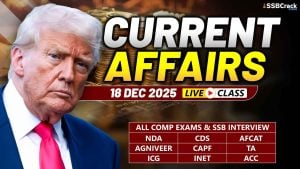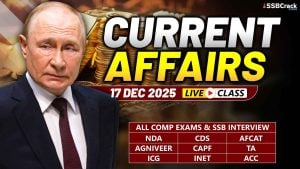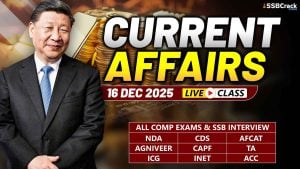Philippines explores options to buy BrahMos missile from India
- India’s ambassador to the Philippines Jaideep Majumdar is on talks with the government.
- The Philippines is one among several countries in Southeast Asia, including Thailand, Indonesia and Vietnam that has shown an interest in purchasing the land and sea-based versions of the supersonic cruise missile.
Rs 47,000 crore LCA fighter aircraft projects to be finalised in next few months: IAF Chief
- The first squadron of these aircrafts has already been operationalized.
- The second squadron of Light Combat Aircraft (LCAs) worth over Rs 8,000 crore would be operationalized by the end of May.
- A contract worth around Rs 39,000 crore for 83 LCA Mark 1A Aircraft will be finalized in the next quarter.
US government in a hurry to get new anti-submarine helicopters into the hands of the Indian Navy
- The US$28 million “Romeo” Seahawk helicopters have advanced combat systems like sensors, missiles, and torpedoes to track and hunt enemy boats and submarines — enough to strike fear in a submarine Captain’s mind.
- The Navy will receive new MH-60R’s in a few years to replace them. The remaining 21 helicopters will be delivered in 2023 and 2024. Most of the changes being made to the aircraft are in the communications and data sharing realm.
- “They want the ability to talk to their satellites obviously, so there’s an Indian indigenous SATCOM data link. Also, they can talk to their ships so there’s a link to that they’ve asked us to install, and there’s some other modifications like a floatation system, and other things that we’ll have to [change] from the standard US Navy configuration,” Tom Kane, director of Sikorsky’s Naval Helicopter Programs told reporters.
- The MH-60R was born to be a sub hunter, however, and that mission will remain central to the Indian configuration. “They’ll come off the line as ASW
aircraft so they’ll have the active dipping sonar,” the AN/APS-153 radar “and things that you would normally see on a US Navy configuration,” Kane told reporters.
- According to Défense News, the helicopters are to be armed with multi-mode radar, Hellfire missiles, Mark 54 torpedoes and precision-kill rockets and are also to be used in limited intelligence gathering roles, for surveillance missions, and in search and rescue efforts.
- The deal is the largest contract Sikorsky has signed with the Indian government. Unlike most other programs, it is not subject to the “Make in India” effort launched by Indian Prime Minister Narendra Modi.
- The Indian defence industry will also likely be involved in any maintenance and retrofit efforts on the aircraft in the coming years.
Indian Army Considers 3-Year ‘Internships’ for Young People to Reduce Costs
- A move that achieves more than one goal must be welcomed. The army is considering a three-year ‘internship’ for young people who do not want a military career but would like to experience its adventure for a time. An internal note spells out the proposal, suggesting a voluntary, not compulsory, tour of duty; a spokesperson of the army has said, however, that the requirements for recruitment will not be relaxed.
- Such a move would save a lot of money. The Indian army is today the third biggest spender in the world, having reached that status after its expenditure grew by 6.8 per cent in 2019. The spending includes salaries and benefits together with operational expenses, equipment, research, construction and so on.
- Even for short service officers who remain in the army for 10 to 14 years, the army spends between five to just below seven crore rupees, while for three-year interns, the expenditure would be less than a crore. The economics makes sense, while internship would not be conscription.
Government accepts Shekatkar panel recommendations on border infrastructure
- In a major boost to building strategic roads along India’s northern border with China, the government on Monday accepted and implemented three important recommendations relating to border infrastructure, made by the Shekatkar Committee in 2016.
- The recommendations accepted were aimed at speeding up road construction in remote areas, providing easier access to the military and leading to socio economic development in the border areas.
- First, the government has implemented the Shekatkar Committee recommendation “to outsource road construction work beyond optimal capacity of Border Roads Organisation (BRO).”
- This is aimed at bringing in private sector road construction agencies and taking the load off a heavily overstretched BRO, which is struggling to maintain the existing network of borders roads and highways, while also building new roads to areas that have remained outside the road network since independence.
- To ensure oversight, the government has made it mandatory to adhere to the Engineering Procurement Contract (EPC) for executing all projects that cost more than Rs 100 crore.
- Second, the government has accepted a Shekatkar Committee recommendation that makes it easier to introduce modern construction plant, equipment, and machinery. For this, the BRO’s “enhanced procurement powers” for domestic and foreign procurements from have been increased from Rs 7.5 crore to Rs 100 crore.
- This is deemed essential, with the BRO engaged in sophisticated road and tunnel construction projects, such as the Atal Behari Vajpayee Tunnel near Manali that underpasses the Rohtang Pass; and the 80-kilometre-long road on the Amarnath Yatra route from Dharchula (Uttarakhand) to Lipulekh (China Border).
- For projects like these, the “BRO has recently inducted Hot-Mix Plant 20/30 TPH for speedier laying of roads, remote operated hydraulic Rock Drills DC-400 R for hard rock cutting, a range of F-90 series of self-propelled snow-cutters/blowers for speedier snow clearance,” stated the defence ministry (MoD).
- The BRO is also introducing advanced new technologies to speed up construction, such as precision blasting, use of geo-textiles for soil stabilisation, using cementitious base for pavements and plastic-coated aggregates for surfacing.
- “With the empowerment of field officers through enhanced delegation of financial and administrative powers, there has been significant improvement in faster financial closure of works,” said the MoD
- Finally, completing land acquisition and obtaining statutory clearances such as forest and environmental clearance will now be pre-requisites for approving the Detailed Project Report (DPR) for a new road. Work can be awarded only after at least 90 per cent of the statutory clearances have been obtained.
- The Shekatkar Committee submitted a total of 99 recommendations. Details of the report and its recommendations have not been placed in the public domain as it “covers operational aspects of the armed forces, disclosure of which is not in the interest of national security,” the government told Parliament in February 2019.
J&K Updates
- An encounter broke out between terrorists and security forces in Nawakadal area of Srinagar on the intervening night of 18-19 May. Mobile internet services have been snapped in Srinagar. More details awaited.
BRO Opened Manali – Leh Axis
- Border Roads Organisation (BRO) said, “On 18 May 2020, Mr Jamyang Tsering Namgyal, MP, flagged in the first convoy of vehicles at Sarchu (boundary between Ladakh & Himachal Pradesh) carrying essential supplies, thus officially opening the Manali- Leh Axis this year.”
- “BRO teams from Project Himank (Ladakh) and Project Deepak (Himachal Pradesh) successfully completed their tasks and the Manali – Leh axis was opened to traffic, three weeks ahead of schedule,” added BRO.
- The work on 475 km Manali – Leh axis commenced on 19 Feb 2020, with an aim to simultaneously commence snow clearance on important passes.
- This route is dotted with five important high altitudes passes namely Rohtang (14,216 ft), Baralachla (16,047 ft), Tanglangla (17,582 ft), Lachungla (16,616 ft) and Nakeela (16,170 ft). Rohtang pass is also significant for Lahaul Valley of the Himachal Pradesh.
- This linking provided immediate relief to villages of Karnak, Samad, Sumdon and Ankung in particular and people of Lahual Spiti and Leh in general.
- The strategically important Manali – Leh highway remains closed for about six months every winter and Ladakh remains cut off from rest of the country which makes the region dependent on supplies through the aerial route.
- Ladakh is linked by only two land routes with the rest of India and these are Srinagar-Leh road and Manali-Leh road passing through Sarchu. Ladakh is strategically important as it shares disputed borders with Pakistan and China with areas like Kargil, Siachen, Daulat Beg Oldi (DBO) falling in this area.
- In its effort to link Ladakh ahead of the schedule BRO had opened 434 km long Srinagar – Leh Road by 15 Mar 2020.
- Due to the high altitude and difficult terrain window for work in this area is short. A plan was made, and latest hi-tech machinery was swiftly inducted and BRO teams worked relentlessly day and night, even during the COVID-19 Pandemic with adequate precautions.
- The plan to open the road ahead of schedule started in January when a high-level meeting was chaired by Dr. Ajay Kumar, Defence Secretary on 27 Jan 2020 where the need for early opening of roads to Leh was emphasized. This began with detailed coordination between officials of BRO, UT Governments of Ladakh and J&K and State Government of Himachal Pradesh. Also, Lt Governor of Ladakh R K Mathur chaired a meeting at HQ Directorate General Border Roads in New Delhi on 20 Feb 2020 and called upon Lt Gen Harpal Singh, DGBR, to expedite the opening of roads to Leh.
- On 11 May 2020, Mr Jamyang Tsering Namgyal, Member of Parliament, approached Lt Gen Harpal Singh, DGBR, to expedite the snow clearance and facilitate return of people stranded in Kullu and Manali to Ladakh and also for the movement of essential supplies and relief material in the wake of COVID-19 as people/ essential supplies otherwise have to travel through Red Zones of Srinagar & Jammu. Only limited number of people could move due to massive screening requirements at these places.
- MP Jamyang Tsering Namgyal conveyed his gratitude to Lt Gen Harpal Singh, DGBR and applauded the tremendous efforts put in by BRO.
- BRO this year has carried out Snow Clearance on 149 roads of length – 3965 Km with a view to ensure that lines of communication in remote high-altitude areas remain open.
Remembering Operation Smiling Buddha
- India’s first successful nuclear bomb test on 18 May 1974.
- The bomb was detonated on the army base Pokhran Test Range, in Rajasthan, by the Indian Army under the supervision of several key Indian generals.
- Pokhran-I was also the first confirmed nuclear weapons test by a nation outside the five permanent members of the United Nations Security Council.
- Officially, the Indian Ministry of External Affairs (MEA) characterised this test as a “peaceful nuclear explosion”.
Remembering Captain Dilip Donde’s adventure
- Captain Dilip Donde (born 26 September 1967) is a retired Indian Naval officer and the first Indian to complete a solo, unassisted circumnavigation of the globe under sail.
- The voyage was the first of the Indian Navy’s project Sagar Parikrama, initiated by late Vice-Admiral Manohar Prahlad Awati (Retd). Capt. Donde started his circumnavigation from Mumbai on 19 August 2009 and finished on 19 May 2010.
- During the nine-month-long circumnavigation he stopped at four ports and was at sea for 157 days.
- INSV Mhadei, custom built by the Indian Navy was used in this.
QUICK REVIEW
- The BRO’s “enhanced procurement powers” for domestic and foreign procurements have been increased from Rs 7.5 crore to:
- Rs 40 crore
- Rs 70 crore
- Rs 100 crore
- Rs 120 crore
ANSWER: C
- Recently, which country is exploring options to buy BrahMos missile from India?
- Germany
- Indonesia
- Philippines
- South Africa
ANSWER: C
- The Leh-Manali Highway connects the Manali valley to which valleys in Himachal Pradesh?
- Nubra and Kathmandu Valleys
- Lahaul and Spiti Valleys
- Gwass-Bagi and Habban
- Joginder Nagar and Kangra
ANSWER: B



















